Welcome to a visual feast of the king of the beasts, as seen in manuscripts and printed books of Lincoln Cathedral Library. Some of the images are realistic and some less so but still evidence of our long term fascination with the magnificent animal found at the top of the food chain.
Oldest Lions
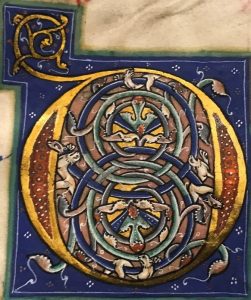
One of our oldest lion’s is the 12th century decorated initial in a manuscript of Peter Lombard’s Sentences (specifically, Psalm 52), described by Rodney Thomson as ‘white lions on square, coloured grounds edged with green’. Can you see them? Look closely!
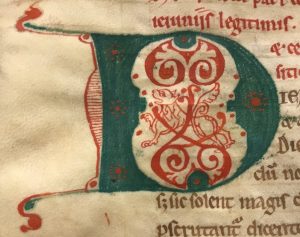
This lonely lion in a 13th century initial from Ivo of Chartres’ Decretum is much easier to spot!
Another 12th century depiction illustrates genealogies of the Counts of Flanders and Kings of France with a lion rampant.

It’s interesting to compare the medieval lions to each other!
Early Modern Lions
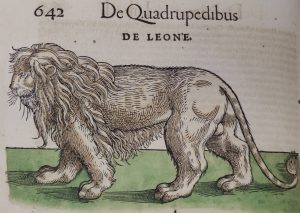
Swiss physician Conrad Gesner is often considered to be the father of modern zoology. His three volume History of Animals was the first comprehensive reference work on the subject, covering quadrupeds, fish, and birds. Illustrated throughout with fine hand-coloured woodcuts, this work attempted to include all the available information on each animal. Although it was intended to be factual, there are many wondrous and mythical creatures scattered throughout each book, including a unicorn. This was the first attempt by anyone to describe the animals and their habitats accurately. If you are visiting Lincoln please do not miss the new exhibition space at the Cathedral. An animated version of Gesner’s rhinoceros will be there in 2022!

The story of the church father Jerome and the lion is a delightful story of a saintly scholar coming to the rescue of a limping lion, removing a thorn from his paw. The lion repaid his kindness by remaining by his side until his death around 420 CE and appears in many paintings with St Jerome. The cathedral owns a beautiful drawing of this story, a hand-coloured illustration with no provenance but visible pin holes where it has been displayed in the past.
The earliest printed book held in the Cathedral Library is a copy of Jerome’s Epistles printed in 1468.
Lions of the Nineteenth Century
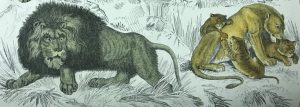
Oliver Goldsmith’s History of the Earth and Animated Nature was first published in 1774, describing the history of the earth, geographical features and many species of animals in eight volumes. The Cathedral has a two volume abridged version, which appeared in 1853. It is mentioned in George Eliot’s The Mill on the Floss, read and enjoyed by Maggie Tulliver.
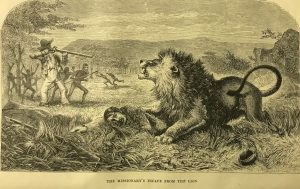
Scottish missionary and explorer David Livingstone (1813-1873) was not enamoured of the artist’s impression of him being attacked in by a lion, which was published in ‘Missionary travels and researches in South Africa; including a sketch of sixteen years’ residence in the interior of Africa’ in 1857 and tried to have it banned. The attack took place in 1844 during a journey to Mabotsa, Livingstone survived the encounter but the lion did not.
The cathedral library also holds a letter from Livingstone addressed to Col Winyard in 1862, detailing the trials and tribulations of travel in Africa at that time, which featured in Lincoln’s Black History Trail in October’s Black History Month, as part of the University of Lincoln’s Reimagining Lincolnshire project. You can learn more at https://reimagininglincs.blogs.lincoln.ac.uk
Lions Today
Throughout the cathedral’s history, lions have sparked the imagination and interest of the people who illustrated, wrote, and collected its books. We hope you have enjoyed getting to know the lions of Lincoln Cathedral Library.
Images shared with the permission of the Dean and Chapter of Lincoln Cathedral. Blog written by Claire Arrand with help from Hope Williard.